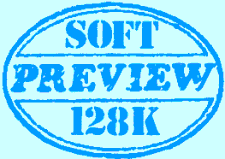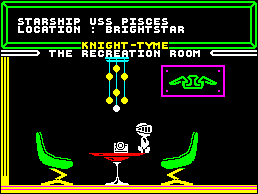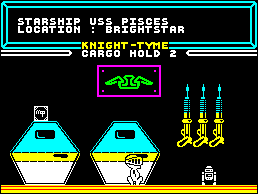| 128 Software |
MASSIVE MAPS ... over-populated galaxies ... high-resolution full-screen graphics ... wit, humour, room to laugh ... that's the sort of thing I was expecting software houses to produce for the 128.
But so far there's only one company that's written a game specifically for the new machine, and it will probably amaze you to learn it's that much-maligned home of the budget quickie, Mastertronic.

While everybody else has been busy upgrading old games by bunging in a few more rooms and a couple of snatches of tasty music, Mastertronic has quietly been working on a genuine 128 game at the astounding price of £2.99 - not a penny more than anything else in its MAD range but considerably bigger and much more spectacular.
Knight Tyme is the sequel to Spellbound and Finders Keepers, both by top Mastertronic programmer David Jones. His new, equally eccentric game is a vast odyssey through space in the company of 16 other characters to find the guardians of time and persuade them to let you through the black hole which takes you back through the centuries. Why do you want to do this? Because it's there ...
Knight Tyme hasn't been finished yet, but I travelled into the wilds of Tronic land - two stops on the tube from El Pueblo Sinclair User - to graciously allow David and his well-heeled bosses to demonstrate the game. After the usual exchange of pleasantries concerning Action Biker the well-bossed heels disappeared and David got on with it.
Knight Tyme is an animated adventure, to coin an obvious phrase. It's not really an arcade adventure, in that you need only use the joystick to position yourself next to the right character or over the right object. On the other hand, the mental agility required to interpret the various problems is considerable.
There are a number of menus which can be accessed when you're not moving around the ship, which allow you to pick up, drop, wear, take off, read, examine and generally muck about with objects, characters and your environment. Those menus will also offer more specific options at appropriate times, such as moving the starship or using transporters to travel to the planet's surface.
What starship? Right. You start the game on the USS Pisces, floating somewhere around the 25th Century on an ostensibly peaceful trading mission. You're trying to return to your own time, but the first thing to do is to get equipped. There are two types of characters involved - droids and real people. Droids will always obey you to the best of their ability but people may ignore you if you are not sufficiently attractive to them.

Let's follow the Magic Knight - you - through the first few stages of the game. He starts off in the Transputer room with a selection of peculiar objects. The white gold ring is a magic item, courtesy of Stephen Donaldson's Covenant Trilogy. David's not afeared of mixing magic and science fiction if he wants. "When you meet the Time Guardians you'll have to prove your skill at magic anyway," he says.
Other objects include an invisibility cloak which can get you past some problems but will make it difficult for characters to understand you, since they can't see you, and an McTablet of concentrated food. There's also an advert which is otherwise useless but if read produces the first of the flipscreens programmed into the game, a panel of Mastertronic self-admiration. These screens are stored in the voluminous 128K memory like standard SCREEN$ and then flipped into the display file whenever you like. In fact, there are particular memory banks within the 128 which can be directly swapped with the screen display in order to instantly reproduce pictures, but David says he didn't use that method for his screens.
Although the advert is a bit of a show-off, there are other pictures hidden away in the program which will be of more immediate relevance. Given the size of the memory, it's quite feasible to fill up spare space with lots of such pictures without damaging the quality of the game - luxury to programmers who in the past have always had to choose between good games or good graphics.
We wander around the spaceship for a bit. There's an armoury, a control room, various holds and several droids sitting around waiting to be told to do something. Not much going on here, David.
David points out that in order to do anything interesting I'm going to need an ID card, and says Derby IV can help. Derby IV turns out to be a computer, who, when asked for help, produces a blank ID. In another room I find a camera and a roll of film - obviously something to do with putting my photo on the card.
Forbin the droid can help here. Droids are semi-biological beings, according to David, which sounds like a hint to give it some food. I proffer the MacTablet.
"Klink says 'Yummy, you can almost taste the side salad in this T-Bone steak tablet'." David explains that there are eight different flavours for the tablets. That's more variety than you get from MacDonalds, anyway.

Klink is then given the camera and the film and told to take a photograph. There's a blinding flash, but it appears the photo hasn't come out. "You're still wearing the cloak of invisibility," explains David, wearily but helpfully.
The graphics for all this are simple but effective. There's no 3D effect but the speed of movement is fast in compensation. Virtually anything that can reasonably be examined or read produces messages on the screen, often quite verbose and very funny. When I finally manage to use the pot of glue to stick the photo - a new, successful one - to the card it turns out to be a special pass signed by King Jones himself. David's nothing if not modest.
Mastering the ship's facilities is only the beginning of the game. You must travel among a wide range of planets in order to discover the location of the black hole. At some of these planets there will be other characters - hostile or helpful, and usually requiring some sort of fee for their services.The ship and its shuttle comprise about 15 rooms, and more than 50 are spread around the various planets.
Messages concerning the other characters may reach you - Murphy, for example doesn't like me, but has a craving for potatoes. Either I'm going to have to find some spuds for him or use my various defences gas, invisibility cloak, magic perhaps, to get past him. There are three basic defences, and all have a corresponding attack form. Cameras are dealt with by the aforementioned cloak, gas by a gasmask, and microphones by the use of special boots.
To say much more about the game would be premature at this stage, but we'll carry a full review as soon as we can. In the meantime Mastertronic do plan to bring out a scaled-down 48K version of the game with less graphics and fewer rooms "or more likely fewer stars" says David. He says it's his intention to use up every byte of the 128K in the final version, and that will make it more than twice as big as anything on 48K.
"If we're going to do anything on the 128K," says Mastertronic's Colin Johnson, "we may as well go all out for it." The difference between that attitude and those of software houses who are only interested in testing the water with a souped-up rewrite is already apparent in what I've seen of Knight Tyme so far.
Perhaps other companies may learn a lesson from Mastertronic and follow suit - because if the new machine succeeds as it deserves to, it's going to need a lot more than Spinoff Raiders Pt IV (128 version) stamped on the cassette inserts to convince people.
Well done Mastertronic. Who's next?
Chris Bourne